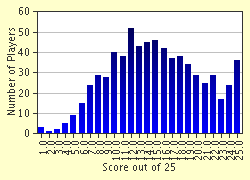Quiz Answer Key and Fun Facts
1. Which era is known as the "age of dinosaurs"?
2. What part of the dinosaurs' skeleton is used to divide them into two basic groups?
3. Which are the two main orders of dinosaurs?
4. In which country were dinosaur fossils regarded as dragon bones?
5. What was the first dinosaur to be described and named scientifically?
6. Were dinosaurs warm-blooded or cold-blooded?
7. Which of these groups of bird-hipped dinosaurs didn't include any bipedal species?
8. Which of the following dinosaurs was a plant-eater?
9. What do you suppose ties these two Mongolian dinosaurs: Velociraptor and Protoceratops?
10. This Cretaceous fossil site in Australia is one of the top "providers" of dinosaur bones in the world.
11. What would a sauropod use gastroliths for?
12. Brontosaurus is perhaps one of the best-known dinosaurs, alongside with T-Rex, Triceratops and few others. In 1903 the former "thunder lizard" was renamed as which of these?
13. Dinosaurs are no longer regarded as the solitary, aggressive, monstrous animals, that they were depicted as several decades ago. Recent discoveries show that most species had well-developed social behaviors, whether they were meat-eaters, hunting in packs, or plant-eaters, living in huge herds. Which of the following species is known for its special care given to the young?
14. Which of these was the smallest meat-eating dinosaur found by the end of the nineteenth century?
15. Spikes and horns! These were the dangerous weapons of the intimidating Ceratopsians. Which one of the following "horned faces" possessed six neck spikes along its protective neck frill?
16. Which of the following species was not discovered in North America?
17. One of the most intriguing dinosaurs ever found is the "scythe reptile", a Mongolian theropod who is believed to have been a plant-eater, despite displaying enormous claws. What is its scientific name?
18. What meat-eating dinosaur is known to have included fish in its diet?
19. What group of dinosaurs were heavily armored with bony studs, plates, spikes, horns and bony tail clubs?
20. This dinosaur is one of the fiercest predators in the whole long history of life on Earth. Its distinctive feature was the "terrible claw" - which is also the meaning of its scientific name. Introducing...
21. The late 1800s saw the birth of the big-scale fossil hunting expeditions. The "First Great Dinosaur Rush" engaged two passionate teams of paleontologists, led by two very ambitious and active experts. One of them was the American Edward D. Cope. Who was his equally famous rival?
22. What present group of animals is commonly thought to be the direct descendant of a dinosaur group?
23. No dinosaur quiz would be complete without a question about the "tyrant lizard king". Tyrannosaurus Rex' myth is still alive although recent discoveries may have shattered its image as the ultimate predator. Which of these facts about T-Rex are likely to be true?
24. When did the dinosaurs become extinct?
25. Paleontology has been a popular science ever since the great fossil hunts began, more than a century ago. Thus, the number of named dinosaur species is now truly amazing. What's the approximate figure?
Source: Author
Mr5
This quiz was reviewed by FunTrivia editor
crisw before going online.
Any errors found in FunTrivia content are routinely corrected through our feedback system.

